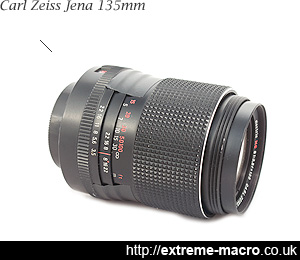Carl Zeiss Jena Sonnar 135mm f/3.5
by Johan J Ingles-Le Nobel
Last updated August 31, 2017
This cult M42 lens by Carl Zeiss has a reputation for being the best M42 135mm lens ever made. It works extremely well as a extreme macro tube lens on APSC with an infinite objective.
a reputation for being the best M42 135mm lens ever madeThe Carl Zeiss Jena 135mm f/3.5 lens has become a popular vintage purchase for modern DSLR owners because it is very very good. The lens is tack sharp and handles colours beautifully - the most striking aspect perhaps being these vibrant warm colours. If you choose not to use it as an extreme macro tube lens then perhaps you should give it a whirl as a regular lens and enjoy its gloriously smooth bokeh, which has bokeh enthusiasts in rapture.
Carl Zeiss Jena 135mm f/3.5 Specifications

Carl Zeiss Jena 135mm f/3.5. As I only ever use this as a tube lens I taped over the focus mechanism so it would always sit at infinity.
The Carl Zeiss Jena 135mm f/3.5 lens has a simple optical design of 4 elements in 3 groups that has stood the test of time. It is thin for a 135mm, taking a 49mm filter, and is an auto aperture with an A/M switch with a nice solid metal retractable hood. The lens measures between 8.4 and 10.5 cm from the front of the camera and is instantly recognisable because of the purple coating on the front.
The minimum focus of the Carl Zeiss Jena 135mm f/3.5 is 90cm and minimum aperture f/22. The diaphragm has 6 blades and there are various versions, one of which has a Japanese ninja 'shuriken' type aperture, characteristic for German-made Contax/Yashica lenses. The designation 'electric' refers to the electric pins on its bayonet that are used for light metering on various camera bodies of the time.
Carl Zeiss Jena 135mm Prices
The Carl Zeiss Jena 135mm f/3.5 lens was included in Praktica camera bundles of the 1970s as the telephoto, and there is no shortage of these around.
4 Elements
Speaking in general terms, the more optical faults you try to correct in a lens, the more lens elements you need. Old lens designs were often limited to a few lens elements because lack of sufficient coatings caused large light losses. Light is reflected (lost) for every lens element, when passing from both sides of the lens element. If the glass reflects 5% of the light, in a 4 lens element design, 66% of the light got through (compared to a multi-coated lens with say 1% reflection, 92%). Lets say they built a lens for the same purpose with 6 elements, that would lose 54%. Therefore, older lenses tend to have less elements.It is available cheaply in second hand camera shops and on eBay, although its iconic reputation and purple front less looks does drive up prices. I picked up a pristine copy from a charity shop for UK £5, but expect to pay £100-£150 on eBay. You may also see it labelled as a Carl Zeiss Jena 135mm Sonnar, or CSJ 135.
M42 Adapter
Of course being an M42 lens does mean an extra M42 adapter in the mix, but if that is the price to pay for an outstanding tube lens then it's a small price. M42 adapters are easily found, but beware that you have the correct 42mm thread. The front filter thread is 49mm.
* Lenses
Carl Zeiss AG is a German manufacturer of optical systems, industrial measurements and medical devices, founded in Jena, an extra M42 adapter in the mix Germany in 1846 by optician Carl Zeiss. An important Zeiss innovation just before the Second World War was the technique of applying anti-reflective coating to lens surfaces.
The technique of applying multiple layers of coating was developed from this basis after the war, and known as "T*" (T-star) for the West German version and MC (Multi Coated) for the East German version. Pentax series of * lenses are perhaps a nod to this Zeiss revolution in lens coatings. The later the variant of this lens, the more and better coatings that were applied. Look especially for 4 digit fifth version of this lens - "Carl Zeiss Jena DDR Sonnar MC f3.5 135 electric", which received the same T* coatings that was later expanded to be included on all Carl Zeiss lenses.
Watch Out For...
they sometimes focus well past infinityThere are a couple of things to watch with this lens. First of all it is not rare to find Carl Zeiss Jena 135mm f/3.5 lenses with non-working diaphragms, this is their weak point, although disassembly is not that tricky. The aperture of many of these lenses stick because of thickening of lubricant used in the blades. The other quirk of this lens is that they do sometimes focus well past infinity.
Carl Zeiss Jena or Carl Zeiss Sonnar?!
... they're the same thing. Carl Zeiss Sonnar was a zebra finish lens (black and silver stripes), was the early version and lacks the integrated hood. The later version is all black, has an integrated hood, and sometimes marked "MC" (which stands for multicoated, the best of the various versions).
Related Articles



